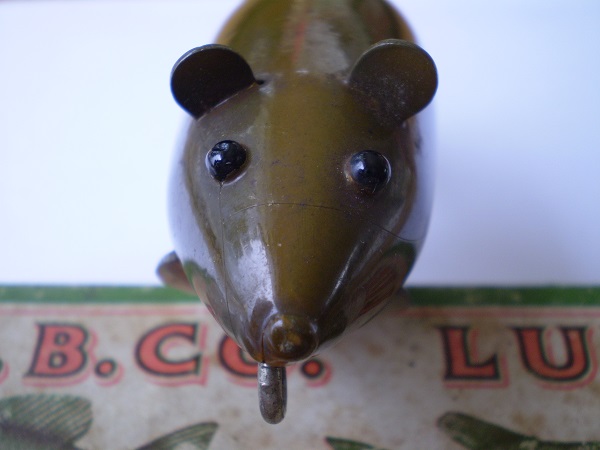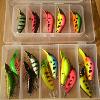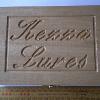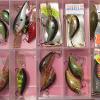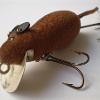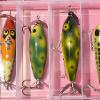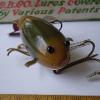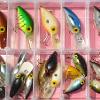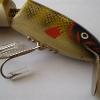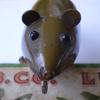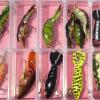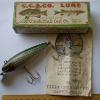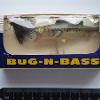Lure Collecting and History
*Cover photo - A Shakespeare 'Pad-ler' Mouse collection
Angling with artificial baits or lures has been a popular method of fishing since the early 20th century however the earliest records of using artificial baits or lures dates back 2000 years to the Mediterranean, with Greeks, Romans and ancient Egyptians also using a form of fishing lure. Polynesians used whale bone and tortoise shell to construct jigs that they successfully used from outrigger canoes. The Australian indigenous people although not constructing lures as such did shape hooks from hardwood, bone and shell that they used on lines to attach a form of bait (they were more commonly using fish trapping techniques and spearing of prey and as expert trappers its possible Aboriginal people had developed some form of lure to attract fish).
Although lures were being made before 1900 they were not common and angling focused more on bait collecting, minnow traps and elaborate bait mounts for presenting a wriggling, tortured frog or baitfish to the hungry quarry. It was medieval live baiting and a highly effective method of angling. Many early lures were metal spinners made by jewelers and featured spinning blades, ornate scroll work and exquisite workmanship. There are also examples of early wooden lures before 1900.
Lure
manufacture evolved from mimicking the action of live prey in the water
- a swimming baitfish or a frog or a struggling insect and humans are
inventive remembering that in the pioneering days of lure angling, the
natural environment held high populations of hungry, predatory fish with
minimal fishing pressure. This has changed in a modern world where
lures that deceive fish need to be more effective than ever due to fish
numbers suffering from ever increased fishing pressure and loss of
critical habitat.
Lure collecting has become a popular pastime and in recent years, as more anglers are looking through their tackle boxes and slowly removing certain lures from use due to rarity or sentimental reasons, lure collections are growing and lure collecting is becoming seriously popular. Fishing lures that have caught a trophy fish or two now belong on the wall of fame in the man-cave because the lure it was caught on may no longer be available!
Australian Lure History - A snapshot:
Australia has a relatively short lure history and is in its infancy compared to USA where collectors have a long, rich history and tradition of lure manufacturing to fall back on. Furthermore the evolution of fishing lures in Australia over the last 200 years since colonisation by the British in 1770 is poorly documented and information prior to 1950 is difficult to find. The first big Australian 'lure craze' was in 1850 with the introduction of the early Scottish made 'Phantom Minnow'. Essentially a salmon or trout lure, the Phantom was quickly accepted and became popular. By the early 20th century and after Federation, Sydney merchants including Eastways were able to offer seven sizes to the angling public. They were made from leather, eel skin, or plastic and according to fishing historian and author Bob Dunn in 'Angling in Australia', there was an adaptation that became popular in Rockhampton in 1914, that used a red belly black snake skin version successfully for barramundi. There is an 1895 account from William Senior fishing the Phantom Minnow for barramundi in the Pioneer River. Also according to Dunn in 'Angling in Australia' the phantom minnow figured prominently in many catches in Tasmania prior to 1900 and an example from a Royal Commission on Fisheries of Tasmania in 1883 describes catches 'as nearly all . . . . caught with the Phantom'.
Some of the earliest specific tackle proprietors around the turn of the century were Eastways est. 1873 and Mick Simmons est. 1877 (Sydney, NSW), Bridges Brothers est. 1860 and Charles Davis est.1847 (Hobart, Tasmania), Allen and Slater (Launceston, Tasmania) and J Allens Fishing Emporium c.1890's (Adelaide, SA). Hartleys Sports Stores in Melbourne came into existence around 1920 after the First World War. Most of the lures in Australia were imported and it wasn't until the 1920's that specific Australian lures started to develop although they were adaptations of earlier models that were released in the UK or USA where most of the imports derived from. These included the big 'Aeroplane Spinners' for Murray Cod, The 'Wagtail' which was an early plastic variation of the Phantom, the 'Sydney Spinner' which was a rotating metal spinner with one or two blades plus the large spoons especially 'Kidney Spoons' which had a good reputation and had been made by J.T Buel as early as 1848 in the USA. The reality was that the majority of anglers either used bait or fly fished before the advent of lures that actually attracted fish. It seemed that most anglers used handlines due to the immense cost of early split cane rods until the advent of a home grown industry to compete with the imported products where rods and reels became affordable and accepted.
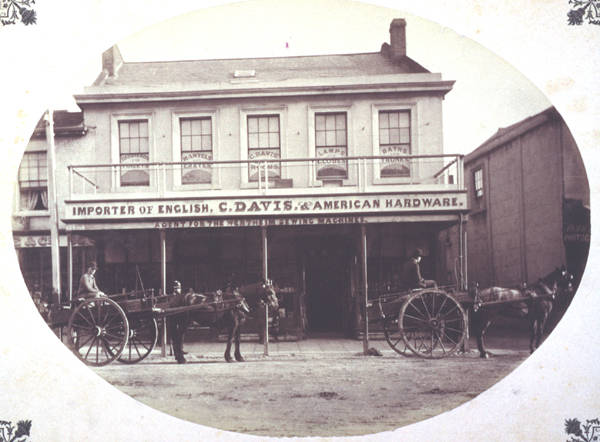
It should be noted that the Enterprise Manufacturing Company (Pflueger) were making versions of the 'famed' Phantom Minnow by 1892 that were made of silk and lighter grade fabrics. By 1895 they were using porpoise or sole skin on their American Phantom Minnow and by 1900 it was called the Indestructible Phantom Minnow.
There is evidence that Pflueger, which was one of the big early American companies, had a presence in Australia as early as 1922/3. They released a pocket catalogue that year called 'Pfluegers 86 High Spots of Fishing Tackle' and there is a version that was specifically printed for a Sydney company of J. B. Meyer who were situated at 26 Imperial Arcade . This catalogue was a small 44 page booklet that intended to feature and promote some of Pfluegers most popular products of the time including many lures.
There is also evidence that representatives from the Pflueger company either came to Australia and visited or had communication with the Hartley's store of the time as there was a fine example of an early Hartley's cod spinner in the Pflueger factory archives.
There were a number of large merchants or trading companies of the time - the large retail trade was in its infancy however Anthony Hordern and Sons Ltd had built the Palace Emporium at Brickfield Hill, Sydney in 1905. The library of the Historic Houses Trust of NSW has catalogues dating from 1894 and this company released lots of specialty catalogues including farming equipment that was available by mail order. The site was 52 acres in size and the company originally started in 1823. Unsure when they started stocking fishing tackle.
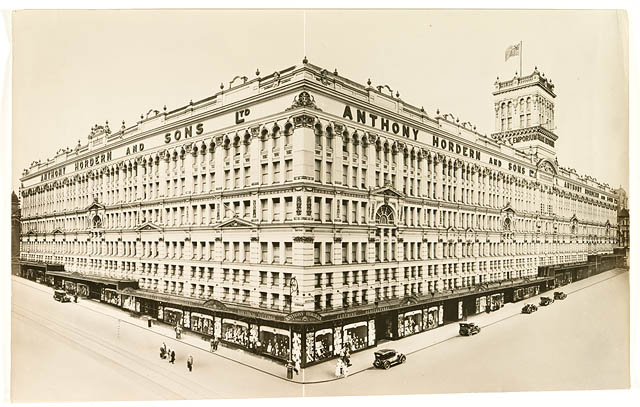
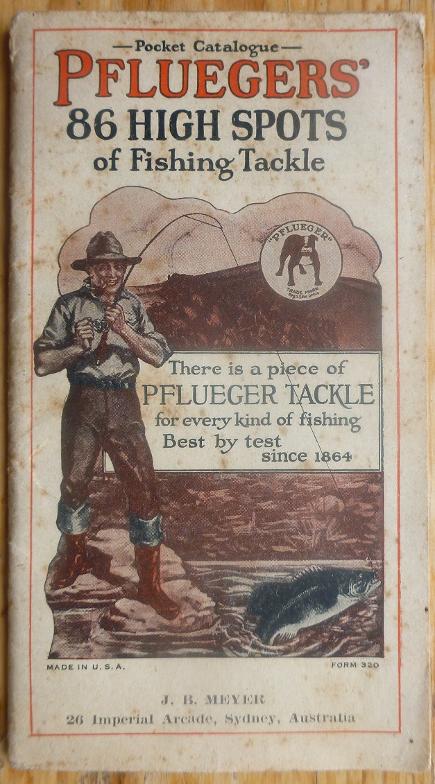
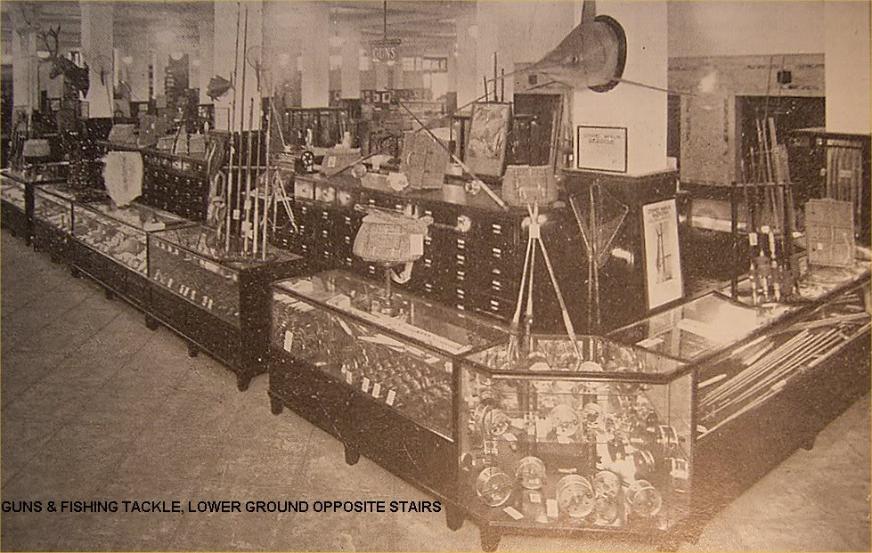
Andrew Hordern and Sons Ltd, Sydney - Guns and Fishing Tackle c 1930's - http://www.collectingbooksandmagazines.com/ah.html
The evolution of the popular 'Devon Minnow' from the UK, the little rotating lures that were used for trout but adapted to Australian native fish had became popular too. The popularity of metal spoons and bladed fishing lures from the USA and Europe spurned a massive industry in itself with the development of big 'Aeroplane spinners' - brands such as Hartleys (1927), 'Aeroplane' brand (1930's), M B Wragg and the 'Alpha' brand from 1931 for Murray Cod fishing. Big kidney shaped spoons accounted for some epic Murray Cod captures that were recorded around 1900. However Pflueger had already successfully made these type of large spinners before 1900 and there are many examples of imported lures such as Hendryx and others found in Australia.
Below shows a page from the 1935 D & W Chandler Ltd catalogue who had two outlets - one in Melbourne central and another in Fitzroy. Apart from the reels that were available (which are interesting in their own right), the lures that were advertised include Aeroplane spinners in 4 sizes up to 4 1/2 inch, traditional Phantom lures in 3 sizes, a Wagtail Bait similar to the Phantom but with a type of early plastic skirt, Devons, spoon bait in 3 sizes and the 'Sydney Spinner' in single and double spinner versions.
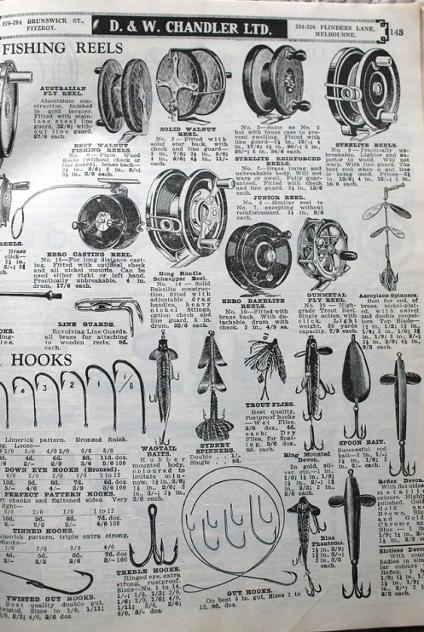
Sweden had entered the Australian market by this time too releasing a non twisting spinner. Advertisement below is an early advertisement for the company that would later become ABU c. 1954.
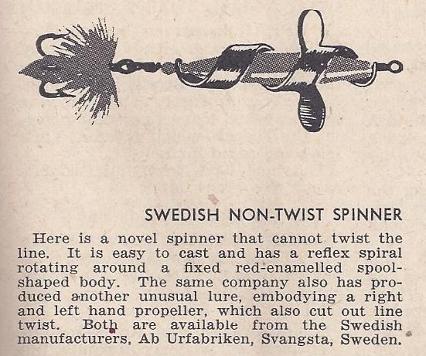
However it was really once monofilament lines were developed and introduced to the angling masses that lure fishing really took off. By 1950 fishing lures were part of a massive marketing strategy by big overseas companies, and with this came price. Field and Stream magazine became available and the Australian publications were starting to emerge like Anglers Digest. Australian spinning reels started hitting the market like the early Graeme and Surfmaster overheads for higher speed spinning that was popularised in the 1970's. These were the years of imports dominating angling sales with Abu, Rapala, Nilsmaster, Helins, Bagleys etc becoming the choices fisherman had. With this came competition and the creative lure makers started the trend we see today.

The example below is of a typical beach store that carried a range of fishing tackle in the 1920's. The Australian isolation required these type of stores to stock a wide range of supplies and they were also agents for the postal service and the Commonwealth Bank. This old photo is at Currumbin Beach, Gold Coast, Queensland.
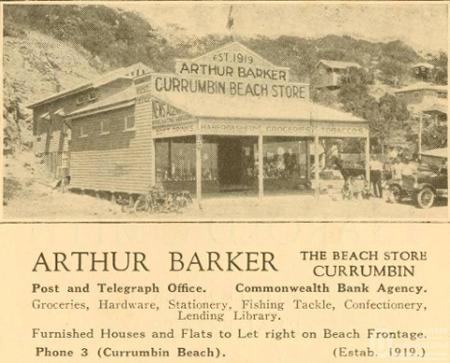
The Australian angling population at this time was quite isolated and the resourcefulness of the early fisherman helped to forge a home grown, cottage lure industry, when imported lures started filtering through to Australia after the wars. Also the Australian ingenuity had started seeing the appearance of simple lures made from spent .303 rifle cartridges or rubber frogs carved from old footwear. Northern NSW fisherman started making lead slugs and spinning them with a bit of white or red rag attached. The classic 'King Billy Pine Jig' , a prelude to the Smiths Jig was used in Tasmania for barracouta due to its colour and density (soft and encouraging repeated bites). Sid Boland made his legendary 'Barra Frog'. The Bellingen timber cutters in NSW made the 'Bellingen Bobber' from the native Australian red cedar (Toona spp) to catch the 'perch' which are indigenous to the rivers of that area.
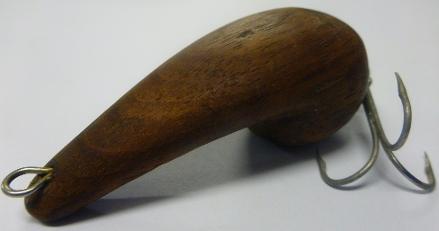
(Above) The Bellingen Bobber
The influx and appeal of imported lures is aptly illustrated in this old page below from a catalogue and price list from Smiths c.1954. The 'Catchmore Spinner' is an interesting design the crops up occasionally, the 'Sydney Spinner' is still listed but suddenly there is the 'French Wobbler', a jointed lure in 2 sizes listed in front of the recently released Bill Southams 'Bellbrook Wobbler' which had been around for 5 years by this time.
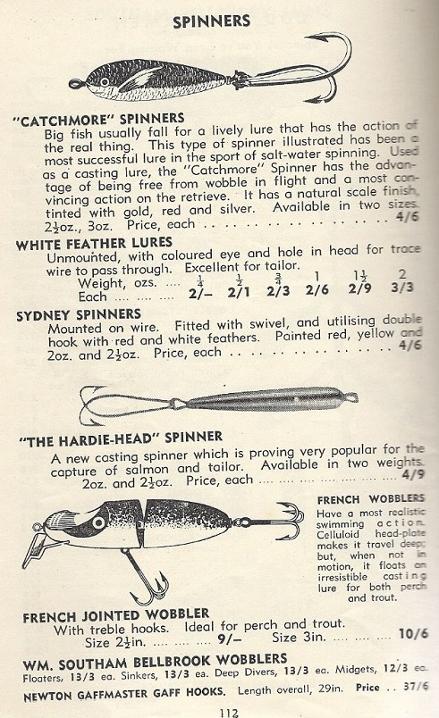
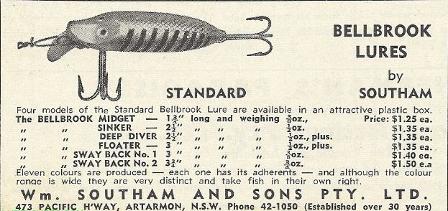
An advertisement for the Bellbrook range of lures from 1966 when the prices had gone to the decimal system of dollars and cents - note the company had now been in business for 30 years.
There were lots of retailers that decided to get into the fishing market but lures were never really the main selling point in those days. Mick Simmons in Sydney were one of the early established businesses that decided to market lures in their advertising. The example left is from Australian Outdoors, November, 1963 which is marketing imported lures including 'assorted spinners', Mitchell lures and also the Dickson range which was imported from Japan at the time and supplied imports through the 1970's. By the time the Rublex 'Flopy' from France had taken the Australian lure market by storm, the beginnings of the cottage Australian industry was well underway.
Now in the second decade of the 21st century Australia has developed into a unique lure making country full of inventive ideas and very special timbers and raw materials. And Australians are fishing and collecting like no other time in history.
What Makes a lure Collectable?
There are so many factors in what makes any particular lure uncommon or rare and thus highly collectable. The main reason is about demand. It may be the age that makes it rare, or the material it is made from for example. But it could also be a rare or uncatalogued colour or a small production run before the model was discontinued. It could also be because it was made by a particular highly valued lure maker who has forged a good reputation for producing a successful pattern. Big USA collectors value the big names and certain old Heddon and Pflueger models command premium prices. Australian collectors are demanding the same - the Newells, RMG'S, Bennetts, Tenterfield and Keith Baker lures. The pioneers of the industry are now being appreciated for the wooden masterpieces they created all those years ago.
Of course the condition of the lure will determine final price and also whether the individual lure is in the correct packaging with a catalogue for example. Its interesting that many Australian lures appear without any packaging or information and collectors are now paying a premium for 'paperwork' and ephemera - early catalogues, packaging inserts, caps, hats, t-shirts, books etc. Values quoted in books and collector guides are based on a mint item (an item unused in original packaging) so values should always be determined allowing for all these factors. The reality is that the market will demand the price according to how many people wish to own any particular lure. Ebay searches, forums, auction sales can all be researched to determine value for most items. Rare items will always be in demand so expect to pay a premium price!!
Australian collectors have recently placed a high price on quality made timber lures with record sales since approximately 2005 via Ebay and private sales on various forums. Most highly collectable lures normally transfer hands via a network of connections in the collector scene however rare finds are still out there for those who invest the effort in searching.
The Australian Collector Scene:
Like anywhere in the world, people will collect anything and they have their own reasons for choosing to collect but the reality is there are some amazing lure collections out there with many different collecting zones. Some will collect just timber lures, or a certain coloured lure, yabby or crayfish lures, frog lures, sinking lures, floating lures, crankbaits, spinnerbaits, old lures and new lures. - collecting is certainly in the 'eye of the beholder'. And it is definitely a fact that an old lure is not necessarily valuable but a newer lure in an uncommon colour may be very valuable due to less being made or less in circulation.
Australian collectors are showing an unrivaled passion for lures that are made within Australia - from cottage industry makers working from home but producing lures in small numbers, a high end product built for Australian conditions and specific native fish. They are patriotic lure purchases and an 'Aussie style' has emerged with big actions and specific shapes becoming ever more popular. There is a massive influx of cheap Asian copies flooding the market every year with some of the highly engineered Japanese plastic lures (that catch fish) holding a large percentage of the Australian lure market. Some are expensive, some are cheap - most cannot be considered collectable although there is a special niche market for these type of lures especially in Japan. Most serious collectors are looking outside this market and concentrate on timber and hand made lures or vintage and collectable lures that have some long term historical value as opposed to just monetary value.
Collecting Lures: What's it all about?
Some of
the most collectable lures are extremely old and date back to the turn
of the twentieth century. The big names include Heddon, Pflueger,
Shakespeare, Creek Chub Bait Company and South Bend, all high profile
USA lure manufacturers. However although all of these major
manufacturing giants have many collectable lures its often the more
obscure makers who produced in smaller numbers that are even more rare
and special to collectors. So if someone mentions a Kimmich 'Special
Mouse' or a Jamison 'Struggling Mouse' to a specialist mouse collector,
they may get a very excited reaction. Similarly if an Australian lure
colector came across some Peter Newell, Norm Edwards or Keith Baker creations they
would have the same reaction. The discovery of 'lure gold' - rare
vintage items that spurn the continued interest in acquiring more lures
for the collection and looking for rare finds.
But lure collecting is also about history - convention vs new ideas. Knowing who influenced a certain pattern and whether it has actually all been done before or is just a variation of the same old themes. Many time has the comment 'Oh its too beautiful to fish' or 'that's a work of art' been heard in reference to a quality hand made lure. It could also be said that items become particularly 'collectable'. A Salvidor Dali or a Picasso that is hardly appreciated at the time but admired after many years of circulation after the artist has passed away. A special note in case is Newell Lures from Tenterfield in Australia where value has increased substantially since the untimely passing of the influential lure maker Peter Newell in 2005.
Creek Chub Bait Company 'Lucky Mouse' c.1936 - Model 5100.
Timber, metal ears and base plate, glass bead eyes and cord tail.
